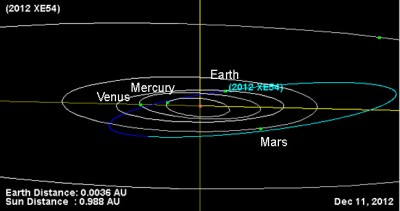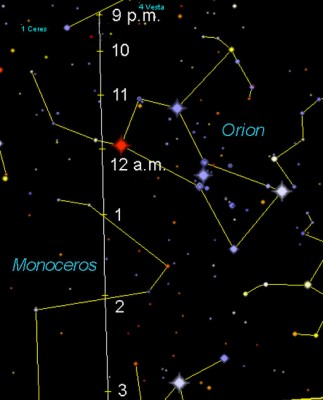A small asteroid – discovered only yesterday – will sweep closely past Earth tonight and possibly undergo an eclipse by Earth’s shadow. If so, that would be a rare event, and something many amateur astronomers will want to see. The asteroid, and the eclipse, will not be visible to the eye. The asteroid has been designated 2012 XE54. Pasquale Tricarico of the Institute of Planetology is saying the asteroid will pass through the Earth’s shadow, creating an asteroid eclipse, an event whose mechanics are much like an eclipse of the full moon by Earth’s shadow.



If the eclipse occurs as Dr. Tricarico suggests, 2012 XE54 will enter Earth’s shadow at 7:22 CST on December 10 (01:22 UTC on December 11) and leave Earth’s shadow at 8:00 p.m. CST on December 10 (02:00 UTC on December 11). Will it be like a lunar eclipse, during which the moon passes through Earth’s shadow? No. At a lunar eclipse, observers on Earth see a dark bite taken from one edge of the moon, which slowly crawls across the moon’s face. An asteroid eclipse can’t be like that, because asteroids appear starlike from Earth – like points of light, even through telescopes. Those watching an asteroid eclipse see the asteroid’s light suddenly dim.
The actual closest approach of the asteroid will occur on December 11, 2012 at 4:10 a.m. CST on December 11 (10:10 UTC).
2012 XE54 is thought to be between 50 and 165 feet across (15-50 meters across), and at its closest it’ll pass only 139,500 miles (224,503 kilometers) away or slightly more than half the moon’s distance (0.6 lunar distances). It’s traveling at just over 13 kilometers per second.
The Observatory of the Hungarian University of Szeged and the Japanese observatory Moriyama confirmed the existence of 2012 XE54 yesterday.
Bottom line: Asteroid 2012 XE54 might undergo an eclipse by Earth’s shadow on the night of December 10-11, 2012. Eclipse may begin at 7:22 CST on December 10 (01:22 UTC on December 11) and end at 8:00 p.m. CST on December 10 (02:00 UTC on December 11). The asteroid will come closest to Earth a few hours later, passing a little more than half the moon’s distance away.











